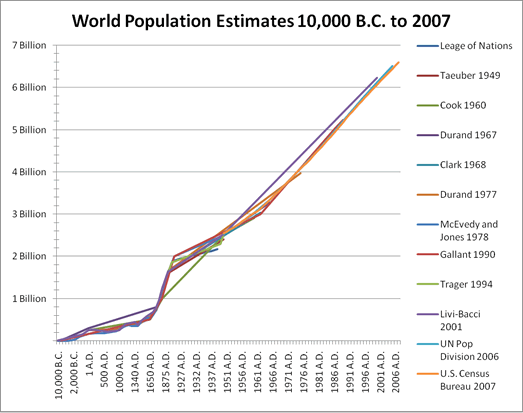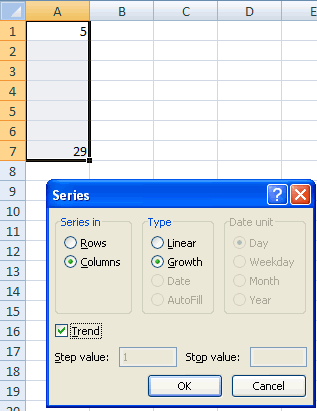There are numerous world population estimates out there. These estimates can differ greatly from one to the next and some are more thorough than others.
Finding estimates for the world’s population in the past 50 years is easy. Moving further back in time, it becomes more difficult. Determining population estimates is the science of educated guessing and there are few people willing to stick their neck out on those guesses when talking about thousands of years ago.
The most “complete” set of estimates is provided by Atlas of World Population History (1978) and more recently by John Carl Nelson in Historical Atlas of the Eight Billion: World Population History 3000 BCE to 2020 (2014). The authors of Atlas’ have broken the number down by region/country and provided estimates from 200 B.C. to 1975 A.D. They do the same for the overall world population and also provide estimates dating back to 10,000 B.C.
Another good set of estimates comes from Population Growth and Land Use (1968). The book doesn’t get as detailed for each region/country of the world, but it does provide world population estimates for the years between 14 A.D. and 1900 A.D.
The League of Nations ((The League of Nations provide estimates for the years 1925-1939 throughout 15 of their published yearbooks. Refer to Appendix: World Population Estimate Sets for complete listing.)), the UN ((Population Division of the Department of Economic and Social Affairs of the United Nations Secretariat, World Population Prospects: The 2006 Revision and World Urbanization Prospects: The 2005 Revision, http://esa.un.org/unpp (accessed April 06, 2007).)), and the US Census Bureau ((U.S. Census Bureau, “Total Midyear Population for the World: 1950-2050,” U.S. Census Bureau, http://www.census.gov/ipc/www/idb/worldpop.html.)) provide nearly complete estimates for each year in the 20th Century.
Certain years in the estimates vary greatly between the different sets. The best example is the 1 A.D. time period. Estimates vary from 170,000,000 ((Colin McEvedy and Richard Jones, Atlas of World Population History (Middlesex, England: Penguin, 1978), 342.)) to 300,000,000. ((J. Durand, “A Long-Range View of World Population Growth,” The Annals of The American Academy of Political and Social Science: World Population 369 (1967), 2.))
Again, being accurate about population estimates from 2,000 years ago is impossible, but by taking all sets of estimates, creating an interpolation to fill in the gaps, and averaging all the estimates, we can get a more complete picture provided by the professionals.
The following chart is comprised of 12 sets of estimates. The complete sets along with sources can be found in Appendix: World Population Estimate Sets.

Filling in the Gaps
Finding estimates for milestone years such as 200 B.C., 1 A.D., or 1,000 A.D. is not difficult; it’s acquiring an estimate for a random year like 760 A.D. that can drive a researcher to madness.
To fill in the gaps between these estimates, a spreadsheet has been created that lists all available estimates from 10,000 B.C. to 2007 A.D. With each set of estimates starting with the first number available, the missing years have been filled in with an interpolation. For example, if an estimate set gives us estimates for 100 A.D. and 200 A.D., the years 101-199 have been filled in using a growth trend to give a more complete estimate (To see the full list of averaged estimates, see Appendix: World Population Estimates Interpolated and Averaged ![]() ).
).
The simplest example can be seen using Microsoft Excel. In the example below, there are 2 numbers that span across 7 years. The first number is 5 and the final number is 29.

By right-clicking the first cell, dragging the mouse straight down to the final cell, and release the right-click button, a menu is presented. The final menu item “Series” is selected.

This presents the Series pop-up. Under Type, “Growth” is selected. The Trend check box is clicked. After that, click the OK button.

The missing numbers are filled in automatically using a Growth Trend. The numbers provided are then 5, 7, 9, 12, 16, 22, and 29. This is useful when determining the interpolation between two population estimates, because these number increase exponentially (2, 2, 3, 4, 6, 7) which imitates the typical growth in population.

This same method can be used to determine the interpolation between two numbers that are decreasing (e.g. 29 through 5 instead of 5 through 29) to help determine a population decrease.
The Caveats
This method is not without its issues.
First, the obvious: The numbers used are purely estimates. Even though these numbers come from historians, scholars, and departments focused on population studies, they are still simply best guesses. The author of A Concise History of World Population described his estimates as being “largely based on conjectures and inferences drawn from non-quantitative information,” ((Massimo Livi-Bacci, A Concise History of World Population, 2nd Ed. (Malden, MA: Blackwell Publishers, 1997), 30.)) which is a fancy way of saying they are educated guesses.
The other caveat is the interpolation will never properly simulate the changes in population. For example, if a population estimate for 100 A.D. is 100,000,000 and for 200 A.D. it is 150,000,000, there is no way to determine what events could have taken place for the population to increase as fast or slow as it did. The population could have reached 160,000,000 in 180 A.D., but due to wars, famine, or plagues, the death rate increased while the birth rate decreased.
We may never have exact estimates for populations in the past, but by using these numbers, we have a more complete consensus from the professionals.
Further Reading
Clark, Colin. Population Growth and Land Use. New York, NY: St Martin’s Press, 1968.
Durand, J. “A Long-Range View of World Population Growth.” The Annals of The American Academy of Political and Social Science: World Population 369 (1967).
Livi-Bacci, Massimo. A Concise History of World Population. 6th ed. 2017.
McEvedy, Colin and Jones, Richard. Atlas of World Population History. Middlesex, England: Penguin, 1978.
Nelson, John Carl. Historical Atlas of the Eight Billion: World Population History 3000 BCE to 2020. 2014.
Population Division of the Department of Economic and Social Affairs of the United Nations Secretariat, World Population Prospects: The 2006 Revision and World Urbanization Prospects: The 2005 Revision, http://esa.un.org/unpp (accessed April 06, 2007).
U.S. Census Bureau. “Total Midyear Population for the World: 1950-2050.” U.S. Census Bureau. http://www.census.gov/ipc/www/idb/worldpop.html (accessed January 10, 2008).
